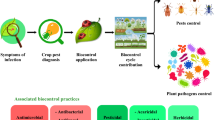Abstract
Spores of Streptomyces melanosporofaciens EF-76, an actinomycete that inhibits the growth of several plant pathogens, were incorporated in beads of chitosan and polyphosphate using the entrapment technique called complex coacervation. The degradation of spore-loaded beads was monitored by measuring the residual amount of chitosan in soil and by enumerating the S. melanosporofaciens population over time. After the introduction of spore-loaded chitosan beads into soil, the amount of chitosan in sterile soil remained at 1.550 mg/g throughout the first week and diminished to 0.101 mg/g after 7 weeks. Bead degradation proceeded faster in non-sterile soil but a progressive release of both chitosan oligomers and the antagonistic microbial agent was nevertheless observed. Application of these spore-loaded chitosan beads to seed potato tubers protected progeny tubers against common scab.




Similar content being viewed by others
References
Agbessi S, Beauséjour J, Déry C, Beaulieu C (2003) Antagonistic properties of two recombinant strains of Streptomyces melanosporofaciens obtained by intraspecific protoplast fusion. Appl Microbiol Biotechnol 62:233–238
Arshady R (1990) Microspheres and microcapsules, a survey of manufacturing techniques. Part II. Coacervation. Polym Eng Sci 30:905–914
Beauséjour J, Clermont N, Beaulieu C (2003) Effect of Streptomyces melanosporofaciens strain EF-76 and of chitosan on common scab of potato. Plant Soil 256:463–468
Boucher I, Dupuy A, Vidal P, Neugebauer WA, Brzezinski R (1992) Purification and characterization of a chitosanase from Streptomyces N174. Appl Microbiol Biotechnol 38:188–193
De Alteriis E, Porro D, Romano V, Parascandola P (2001) Relation between growth dynamics and diffusional limitations in Saccharomyces cerevisiae cells growing as entrapped in an insolubilised gelatine gel. FEMS Microbiol Lett 195:245–251
Doumbou CL, Hamby Salove MK, Crawford DL, Beaulieu C (2001) Actinomycetes, promising tools to control plant diseases and to promote plant growth. Phytoprotection 82:85–102
Goyer C, Vachon J, Beaulieu C (1998) Pathogenicity of Streptomyces scabies mutants altered in thaxtomin production. Phytopathology 88:442–445
Hadwiger LA, Ogawa T, Kuyama H (1994) Chitosan polymer sizes effective in inducing phytoalexin accumulation and fungal suppression are verified with synthesized oligomers. Mol Plant Microbe Interact 7:531–533
Hammad AMM, El-Mohandes AO (1999) Controlling Fusarium wilt disease of cucumber plants via antagonistic microorganisms in free and immobilized states. Microbiol Res 154:113–117
Igarashi Y, Iida T, Yoshida R, Furumai T (2002) Pteridic acids A and B, novel plant growth promoters with auxin-like activity from Streptomyces hygroscopicus TP-A0451. J Antibiot 55:764–767
Jobin G, Grondin G, Couture G, Beaulieu C (2004) Microscopic examination of chitosan-polyphosphate beads with entrapped spores of the biocontrol agent, Streptomyces melanosporofaciens EF-76. Microsc Microanal 11:1–12
Kaş HS (1997) Chitosan: properties, preparations and application to microparticulate systems. J Microencapsul 14:689–711
Kortemaa H, Rita H, Haahtela K, Smolander A (1994) Root-colonization ability of antagonistic Streptomyces griseoviridis. Plant Soil 163:77–83
Lau PS, Tam NFY, Wong YS (1998) Effect of carrageenan immobilization on the physiological activities of Chlorella vulgaris. Biores Technol 63:115–121
Mi FL, Shyu SS, Kuan CY, Lee ST, Lu KT, Jang SF (1999) Chitosan-polyelectrolyte complexation for the preparation of gel beads and controlled release of anti-cancer drug. I. Effect of phosphorous polyelectrolyte complex and enzymatic hydrolysis of polymer. J Appl Polym Sci 74:1868–1879
Nanjo F, Ishikawa M, Katsumi R, Sakai K (1990a) Purification, properties, and tranglycosylation reaction of β-N-acetylhexoaminidase from Nocardia orientalis. Agric Biol Chem 54:899–906
Nanjo F, Katsumi R, Sakai K (1990b) Purification and characterization of an exo-β-D- glucosaminidase, a novel type of enzyme, from Nocardia orientalis. J Biol Chem 265:10088–10094
No HK, Park NY, Lee SH, Myers SP (2002) Antibacterial activity of chitosans and chitosan oligomers with different molecular weights. Int J Food Microbiol 74:65–72
Pridham TG, Anderson P, Foley C, Lindenfelser LA, Hesseltine CW, Benedict RG (1956–1957) A selection of media for maintenance and taxonomic study of Streptomyces. Antibiot Annu 1956–1957:947–953
Reissig JL, Strominger JL, Leloir LF (1955) A modified colorimetric method for the estimation of N-acetylamino sugars. J Biol Chem 217:959–966
Roy S, Leclerc P, Auger F, Soucy G, Moresoli C, Côté L, Potvin D, Beaulieu C, Brzezinski R (1997) A novel two-phase composting process using shrimp shells as an amendment to partly composted biomass. Compost Sci Util 5:52–64
Terbojevich M, Cosani A (1997) Molecular weight determination of chitin and chitosan. In: Muzzarelli RAA, Peter MG (ed) Chitin handbook. European Chitin Society, Atec Grottammatare, Italy, pp 87–101
Toussaint V, Valois D, Dodier M, Faucher E, Déry C, Brzezinski R, Ruest L, Beaulieu C (1997) Characterization of actinomycetes antagonistic to Phytophtora fragariae var. rubi, the causal agent of raspberry root rot. Phytoprotection 78:43–51
Valois D, Fayad K, Barasubiye T, Garon M, Déry C, Brzezinski R, Beaulieu C (1996) Glucanolytic actinomycetes antagonistic to Phytophtora fragariae var. rubi, the causal agent of raspberry root rot. Appl Environ Microbiol 62:1630–1635
Vorlop KD, Klein J (1987) Entrapment of microbial cells in chitosan. Methods Enzymol 135:259–268
Acknowledgements
This work was supported by a grant from the Conseil de Recherches en Pêches et en Agroalimentaire du Québec and the Natural Sciences and Engineering Research Council of Canada. Chitosan was kindly donated by Marinard Biotech. We thank J. Beauséjour and N. Clermont for their technical assistance and B. Talbot for a critical review of the manuscript
Author information
Authors and Affiliations
Corresponding author
Rights and permissions
About this article
Cite this article
Jobin, G., Couture, G., Goyer, C. et al. Streptomycete spores entrapped in chitosan beads as a novel biocontrol tool against common scab of potato. Appl Microbiol Biotechnol 68, 104–110 (2005). https://doi.org/10.1007/s00253-004-1843-8
Received:
Revised:
Accepted:
Published:
Issue Date:
DOI: https://doi.org/10.1007/s00253-004-1843-8




